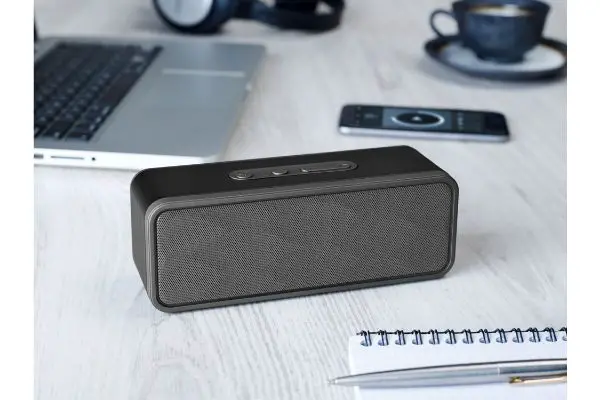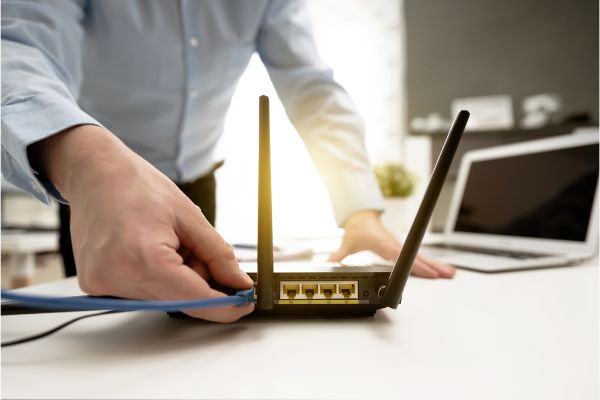Disclaimer: This post may contain affiliate links, meaning we get a small commission if you make a purchase through our links, at no cost to you. For more information, please visit our Disclaimer Page.
Do you have a slow Wi-Fi connection? It might be because of Bluetooth. Many people don’t realize that Bluetooth can interfere with their Wi-Fi signal, causing it to run slowly. If you’re having this problem, don’t worry – we have five ways to solve it!
Table of Contents
Why Is My Wi-Fi Slow When Bluetooth Is On?
Both Bluetooth and Wi-Fi are wireless technologies that use the same radio frequencies, so it’s reasonable to say that having them both enabled at the same time would interfere with each other’s performance.
Both use the 2.4 GHz band, but Bluetooth uses a technique called frequency hopping, also called fast frequency-hopping spread spectrum (FHSS) that constantly changes which frequency it is using.
Wi-Fi uses a single frequency for all its data transfers, also called Direct Sequence Spread Spectrum (DSSS).
The theory goes that since both technologies are fighting for the same frequencies, having them both enabled at the same time would cause slower speeds for both.
So, if you’re experiencing slow Wi-Fi speeds and you have Bluetooth enabled on your device, try turning off Bluetooth and see if that improves your Wi-Fi speed.
You can also try moving your Bluetooth device away from your Wi-Fi router to reduce interference.
Does Bluetooth Affect Wi-Fi?
In short, yes. While the effect is usually minimal, it is still something you should know if you’re experiencing slow Wi-Fi speeds.
If you suspect that Bluetooth might interfere with your Wi-Fi connection, try disabling Bluetooth and see if that improves your Wi-Fi speed.
You can also try moving your Bluetooth device away from your Wi-Fi router to reduce interference.
Does Bluetooth affect 5GhZ Wi-Fi?
No, Bluetooth does not affect the performance of a 5GHz Wi-Fi network.
The two technologies operate on different frequencies, so they should not interfere with each other.
Does Bluetooth Interfere with 2.4 GHz Wi-Fi?
Yes, Bluetooth can interfere with Wi-Fi signals that operate on the same frequency.
The theory goes that since both technologies are fighting for the same frequencies, having them both enabled at the same time would result in slower speeds for both.
How Do I Stop Bluetooth From Interfering With My Wi-Fi? 5 Ways To Solve It
Let’s look at a few things you can do to stop Bluetooth from interfering with your Wi-Fi:
1. Disable Bluetooth When You’re Not Using It
If you don’t need to use Bluetooth, then the simplest solution is to just disable it. You can usually do this from your device’s settings menu. Just look for the Bluetooth setting and toggle it off.
Some devices also have a physical switch that you can use to disable Bluetooth. If your device has one of these, make sure it is set to the “off” position.
With Bluetooth disabled, you won’t be able to use any wireless peripherals, but your Wi-Fi should be back up to speed.
Of course, this isn’t a very convenient solution if you actually need to use Bluetooth regularly.
2. Change the Wi-Fi Channel
If you’re using a router that supports both the 802.11ac and 802.11n standards, then it probably has two wireless networks: one on the “regular” Wi-Fi frequencies (channels one through 11) and one on the newer, less crowded five GHz frequencies (channels 36 through 48).
The latter is sometimes referred to as “Wi-Fi ac.” To see if your router supports this standard, look for the “ac” logo on the box or in the manual.
If your router does support it, try connecting to the 5 GHz network instead of the 2.4GHz. networks. The trade-off is that 5 GHz networks have a shorter range than their 2.4 GHz counterparts, so you might have to be in closer proximity to your router to get a signal.
If your router doesn’t support the 802.11ac standard, you can still try changing the channel that your Wi-Fi network is using.
To do this, log into your router’s web interface and look for the “Wireless” or “Wi-Fi” settings.
From here, you should be able to see all the available channels and select the one with the least interference. Try using channels 1, 6, and 11 if possible since these are non-overlapping and stable.
If you’re unsure which channel to use, your router might have a “scan” feature that automatically selects the best channel for you. Consult your router’s documentation to see if this is an option.
Once you’ve changed the channel, save your settings and see if that improves your Wi-Fi speed.
3. Use a Different Wireless Protocol
If you’re using an older wireless standard (802.11n or earlier), you might be able to improve your Wi-Fi speed by switching to the newer 802.11ac standard.
To do this, log into your router’s web interface and look for the “Wireless” or “Wi-Fi” settings.
From here, you should be able to see all the available wireless standards and select 802.11ac. Once you’ve made this change, save your settings and see if that improves your Wi-Fi speed.
Keep in mind that not all devices support the 802.11ac standard, so you might have to connect some of your devices using an older wireless protocol.
4. Move Your Router
This might seem like an obvious solution, but it’s often overlooked.
If your router is in a central location, moving it closer to the devices you’re trying to connect can sometimes improve signal strength and speed.
Of course, this isn’t always possible (or practical), but it’s worth a try if you’re having trouble getting a good Wi-Fi signal.
You can also try moving your router higher up off the ground. This will help reduce interference from objects that might be blocking the signal. If you have a multi-story home, placing the router on a higher floor can also be helpful.
Just keep in mind that walls and other obstacles can still block the signal, so you might not get the best possible performance.
Another thing to remember is that microwave ovens and cordless phones can also interfere with Wi-Fi signals, so try to keep these devices away from your router if possible.
5. Bluetooth Coexistence Option Of Wireless Routers
If you have a router that supports the 802.11ac standard, then it probably has a “Bluetooth Coexistence” option.
This is a feature that allows Bluetooth devices to connect to the router without interfering with the Wi-Fi signal. However, this feature can sometimes cause more problems than it solves.
If you’re having trouble with your Wi-Fi speed, try disabling the Bluetooth coexistence option and see if that helps.
To do this, log into your router’s web interface and look for the “Wireless” or “Wi-Fi” settings. From here, you should be able to find the Bluetooth coexistence setting and disable it. Once you’ve made this change, save your settings and see if that improves your Wi-Fi speed.
Final Thoughts
There are several things that can cause Wi-Fi speed issues, but the good news is that there are also a number of things you can do to fix them.
If your Wi-Fi is slow, try one (or all) of the solutions in this article and see if that helps.
The best solution will depend on your specific situation, so it might take some trial and error to find the right fix. But with a little patience, you should be able to get your Wi-Fi speed back up to where it should be.


